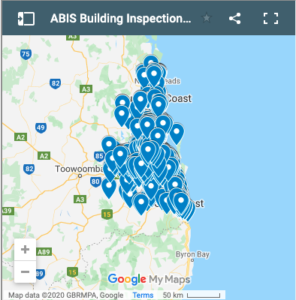Common Building Defect Statistics Compiled from ABIS Building and Pest Inspections

Our Analysis of 3000 Recently Conducted Building Inspections Identified the Following Common Faults:
33% of homes had incomplete construction
In most cases, this was due to pergolas not having eaves gutters and / or downpipes which connect to stormwater drains. Where this occurs, the pergola may not have had local government building approval. 30% of homes had either pergolas, rooms built-in under the house or new additions that were not likely to have had local government building approval as they were not constructed to any recognised standard.
25% of homes displayed evidence of structural cracking and movement
Common causes of these problems were: poor slab construction on cut-and-fill sites; the prolonged dry spell affecting ground moisture; the absence of control joints in brickwork; tree roots; and excessive moisture adjacent to or under the house. In some cases these homes showed cracking and movement of a severity that posed significant danger to the occupants. Root systems of existing or recently removed shrubs and trees may also change moisture levels in the ground which may in turn contribute to structural cracking. 90% of properties had trees or shrubs close enough to the house to cause problems.
Although small cracks may not be harmful in themselves, they may allow moisture penetration to reinforcement which may cause progressive corrosion, leading to a structural problem. Retaining walls were often found to be overturning or cracking, indicating insufficient support or poor drainage.
In a small number of cases (5%), sagging, bowing, cupping and distortion under load were found in structures
- Inadequately secured roof framing
- Sagging pitched roofs due to increased roof loading, corroded fixings or inadequate framing
- Deflected slabs due to substandard workmanship, drying shrinkage or excessive loading
- Sagging timber floors due to under-designed floor framing, insufficient structural support inadequate fastening, poor workmanship, over-loading or timber pest damage
- Dampness which had actually damaged the structural integrity of whole or part of a building was found in one in sixty cases
- Common sources are defective plumbing, defective roof plumbing and flashings, rain penetration, rising damp, condensation, and hygroscopic salts and efflorescence.
13% of homes displayed structural timber pest damage which had damaged the integrity of part or the entire property
The most common timber pest is fungal decay caused by moisture, followed by subterranean termites; wood boring insects and chemical delignification (break down of the timber fibres by salts or pollution in the air).
33% of homes had significant conditions which would lead to structural damage
- 33% of e cases had defective plumbing, roof plumbing and flashings as evidenced by nonexistent rainwater goods, lack of general stormwater drainage, faulty or decayed flashings, cracked or weathered roof cladding, and decayed ridge capping, gutters and downpipes
- 20% of homes had nonexistent or defective damp-proof courses bridged by earth, paths, flooring or additions. Poor surface drainage around many properties was a significant problem.
- 4% of homes had been constructed either in untradesmanlike manner or using inappropriate or inferior materials. Construction was unsatisfactory, sometimes to the point of being dangerous with flimsy handrails, unstable stairways, omission of structural members, excessive notching of structural timbers, insufficient support by over-spanned framing or using under-strength timber. In some instances (one in fifty cases), there was a lack of adequate subfloor ventilation allowing for natural air movement below suspended timber floors to protect against degradation of timber caused by fungal decay and timber pest attack.
- 13% of homes had evidence of surface breakdown or corrosion and loss of thickness to metal joists, beams, and handrails. This may eventually lead to structural damage
50% of homes required urgent attention to secondary and finishing elements
- 40% of homes had moisture problems behind the shower wall or in cupboards below the kitchen taps either visible or recorded by an electronic moisture meter
- 50% of homes had decayed timbers to fencing, pergola uprights and stairs due to poor maintenance, defective rainwater goods or building timber straight into ground
- 33% of homes had problems with stairs and balconies, corrosion or handrails not meeting current building requirements for safety, although fine for their time of construction
- 75% of homes with pools had nonexistent, inappropriate or compromised pool fencing which posed a safety threat
- 25 % of homes displayed corrosion to gates, stairs, downpipes, eaves and gutters
- 50% homes needed to have ridge tiles re-pointed and capped
- 50% of homes had bathroom and kitchen tiles which were cracked and drummy. This is significant because repairs and waterproofing to wet areas can involve substantial costs
- 66% of homes had gutters and downpipes which were either nonexistent or had a problem with corrosion and needed repair or replacement which may lead to serious problems as a result of poor drainage and dampness
- 50% of homes had cracked or weathered roof tiles again threatening serious structural problems as a result of poor waterproofing
The following less significant maintenance problems were common
- 50% of homes had problems with sealants and grouting.
- 33% of homes had cracked or holed internal plaster walls in need of patching and repair
- 30% of homes had ceiling plaster which was damaged and needed repair
- 20% of homes needed repainting internally
- 33% of homes had door and cupboard latches and hinges and countertops to vanities, and kitchen cupboards which needed replacement or repair. Windows often needed easing, sliding doors needed attention and shower screens were often cracked
- 18% of homes had a problem toilet, commonly a worn flange or broken stop-cock




